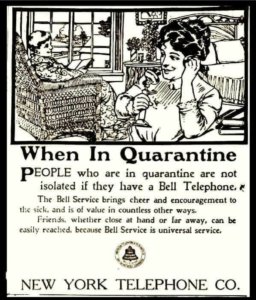
It’s Good to Talk
It’s more than 100 years old now, but the vintage AT&T “When in quarantine” advertisement promoting inventor Graham Bell’s humble telephone has enjoyed something of a renaissance in the digital age – and certainly has seen increased resonance in the age of Covid-19. “People who are in quarantine are not isolated if they have a Bell Telephone,” boasted the ad which predated the deadly onset of the 1918 Spanish Flu which claimed the lives of more than 50m people.

When that pandemic did sweep the globe, the need to communicate overwhelmed the operations of the nascent Telcos. In a notable repeat of history, the Financial Times recently reported a surge of up to 50 per cent in the number of phone calls being made over mobile and landline networks in the UK during March. This put Britain’s telephone system under huge pressure. People can’t visit their loved ones but still want to keep in touch.
Voice is back
Technology has advanced in ways unimaginable to Bell. But the existential need to connect with loved ones has not abated. If anything, communications, grounded as it still is in the mobile industry, has never been more important to the world’s economy and its citizens, almost 6 billion of whom will be mobile subscribers by 2025 according to GSMA statistics.
The evidence of the resurgence in demand for voice is coming through clearly to businesses focused on facilitating calling such as calling app Talk360 which has seen demand for its product skyrocket in recent months, as the virus took hold. The sustained spike in calls to humble landlines has not surprised Talk360 greatly and they believe it tells a story about our need to connect. Their data provides a tracker to the virus – showing large spikes in calls when a country was about to go in lockdown and during.
Our own data speaks volumes about people’s need to stay connected – Ding has seen an almost 50% increase in demand for online mobile top-up since the pandemic begun as family try to stay connected.
Mobile network providers have also noticed an increase in activity for both voice calls and WiFi calls since a number of countries imposed confinement. Voice calls were up 33% in March according to AT&T. Spanish telecommunications giant Telefonica reported that networks experienced an explosion in traffic during March, with a 50% increase in voice calls. To put the increase in the volume of voice calls into perspective, the Financial Times reported that the number of phone calls made over the O2 mobile network surged 50 per cent on one day which was the equivalent to seven years of growth in 24 hours!
The New York Times reported that telecommunications providers in the US had prepared for a shift toward more internet use from home due to new working routines. What companies hadn’t foreseen was “an even greater surge in plain old voice calls, a medium that had been going out of fashion for years”. A phone call can help the elderly population who are cocooning to keep in touch with the outside world and it can also combat loneliness.
Calling across the digital divide
We still live, for the most part, in a prepaid mobile phone world, and one with a profoundly deep – and worrisome – digital divide. We sometimes overlook the fact that prepaid mobile phones, account for upwards of 80pc of the world’s five billion phones. Notwithstanding the ubiquity of smartphones and other cutting edge devices, meaningful connectivity is still a huge privilege to enjoy. In these turbulent times, people seem to need the comfort of a voice on the other end of the line.
Some 4 billion people have no access to the internet as billions more struggle with inadequate access and, critically, affordability. Indeed, it is the continued reliance upon, and resilience of existing infrastructure – such as the humble landline and prepaid mobiles – which speaks to the critical importance of “old world” communications channels for families and businesses around the world in these uncertain times. The voice call, a relatively low-tech means of communication, has proved to be hugely important during the current pandemic.
At Ding, we see this need to connect and to be informed in real time: operating in more than 140 countries, with more than 550 operator partners, we too have witnessed an unprecedented surge in traffic. The surge in data plans, as well as voice calls, paint a vivid picture of how we are connecting and reacting to – as well as transacting through – the greatest public health crisis in modern history.
Like the mercurial enemy we are meeting in the face of Covid-19, it is impossible to predict – in this first wave of the crisis at least – what long term changes to our global economy and society it will bring. But one thing’s for sure: rumours of the death of the humble phone call are sorely exaggerated. And whatever else happens, it seems it is always be good to talk.